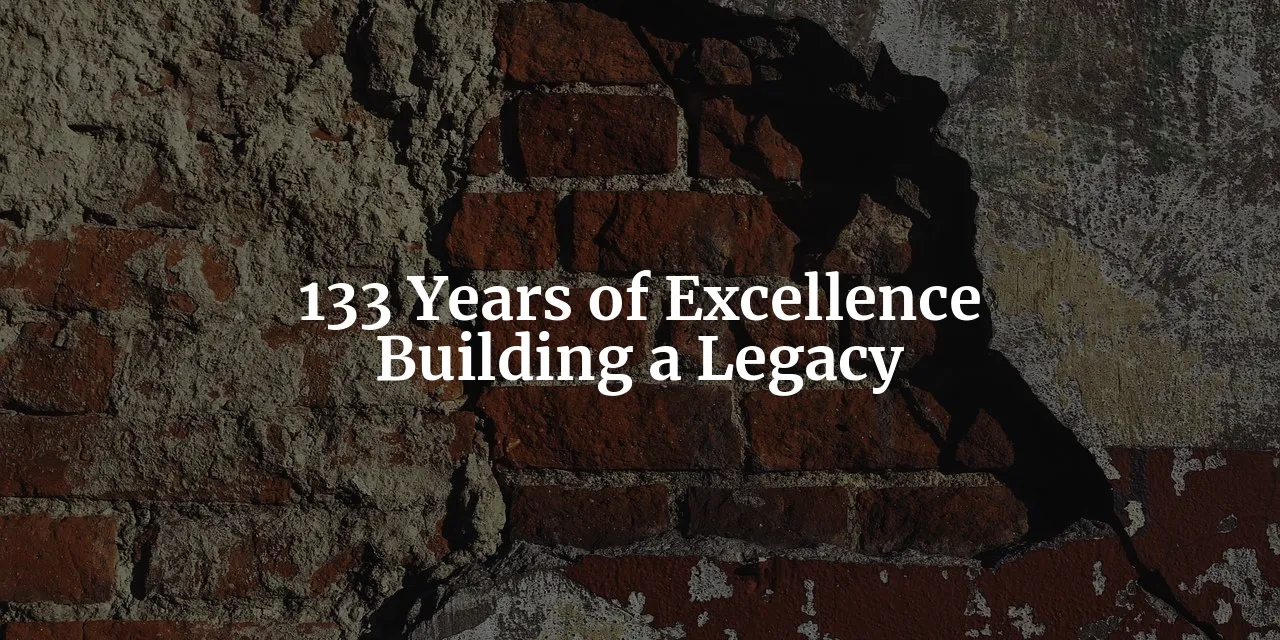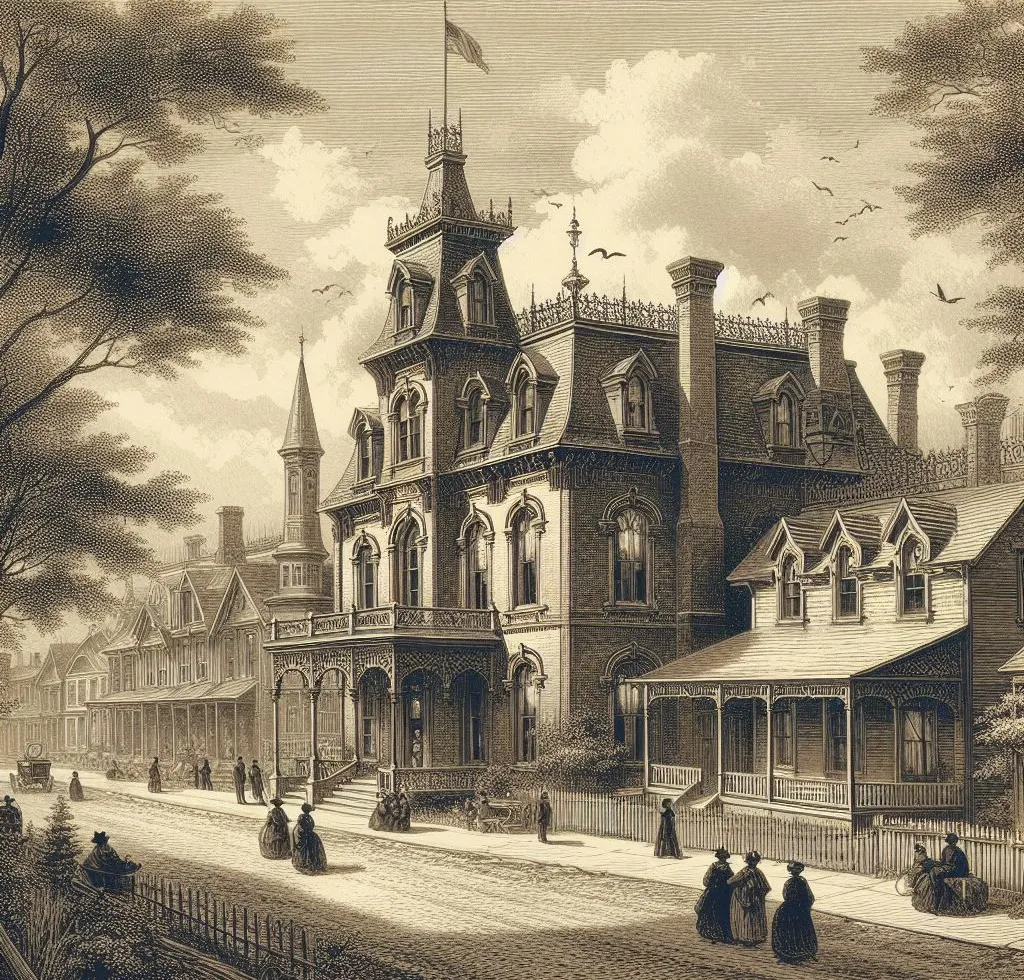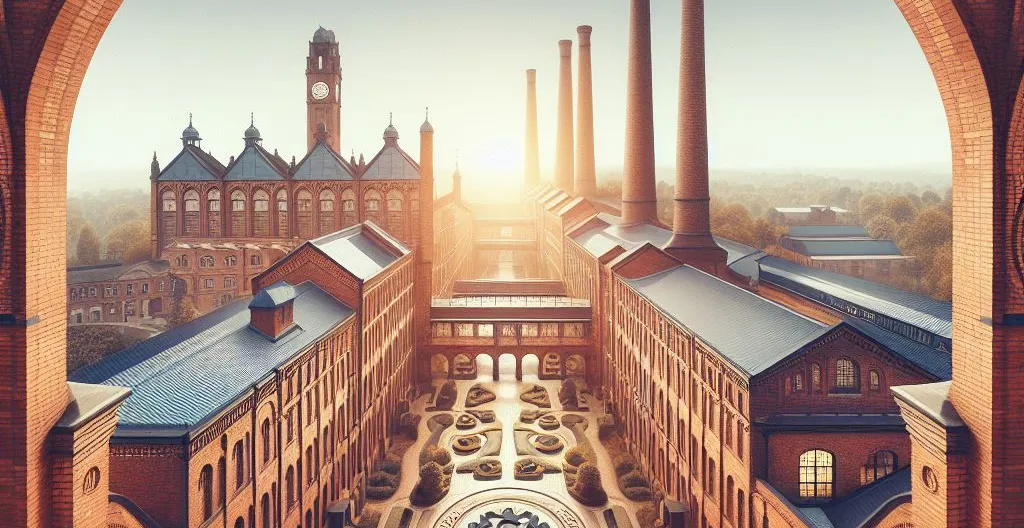Tags: Acme Brick / History
This fanpage is not officially affiliated with Berkshire Hathaway: Disclaimer
The 133-year legacy of Acme Brick Company is a cornerstone in American manufacturing. Explore the rich history, resilience through wars and economic shifts, sustainability efforts and iconic architectural contributions of Berkshire's legacy subsidiary. Embark on a journey of quality and enduring success in the construction industry!

Introduction
As Acme Brick Company marks its 133rd anniversary, it stands not only as a testament to enduring American enterprise but also as a pivotal asset within the vast portfolio of Berkshire Hathaway. Founded on April 17, 1891, Acme Brick has grown to become the largest American-owned brick manufacturer, playing a crucial role in shaping the architectural face of the United States 1. The acquisition by Berkshire Hathaway in 2000 marked a significant milestone, aligning Acme with one of the most revered conglomerates globally 1.
This article aims to delve into the rich tapestry of Acme Brick's history, exploring its foundational years, technological innovations, and the significant role it has played in the construction industry. As we celebrate this 133-year legacy, it's essential to understand how Acme Brick has not only contributed to building homes and structures but has also been a cornerstone in the economic and political landscapes it operates within.
For shareholders of Berkshire Hathaway and the broader business community, this anniversary is a moment to reflect on the strategic decisions that have steered Acme Brick through more than a century of challenges and triumphs. By weaving historical references into our narrative, we will provide a comprehensive view of how Acme Brick has become synonymous with durability, innovation, and American craftsmanship.
Foundational Years and Early Growth
The journey of Acme Brick began in the small town of Parker County, Texas, when George E. Bennett laid the foundation for what would become a cornerstone of American manufacturing 1. The choice of location was strategic, capitalizing on the rich clay deposits essential for high-quality brick production, a resource that has been utilized for over a century in the region 7.
In its nascent stages, Acme Brick faced numerous challenges typical of the era, including fluctuating economies and the logistical hurdles of a pre-automobile society. Yet, the company was quick to adapt and innovate. The introduction of tunnel kiln technology in the mid-19th century, a significant advancement in brick firing processes, was among the early technological adoptions that propelled Acme forward 9.
The period also saw significant historical events that contextualized the era of Acme's rise. The year 1891, marking Acme's founding, was notable for other milestones: the first concert at Carnegie Hall conducted by Pyotr Ilych Tchaikovsky and the presidency of Benjamin Harrison, reflecting a period of cultural and political dynamism 9. These events underscore the transformative times during which Acme Brick was establishing its foothold.
Expansion was rapid and strategic, with Acme extending its reach beyond Texas. By the early 20th century, Acme had become synonymous with the American construction boom, laying down the literal building blocks for hundreds of thousands of homes, schools, and historic buildings across the nation. This period was marked by significant milestones and technological advancements, which are summarized in the table below:
| Year | Milestone |
|---|---|
| 1891 | Founding of Acme Brick by George E. Bennett in Parker County, TX |
| Early 1900s | Adoption of tunnel kiln technology enhancing production efficiency |
| 1921 | Expansion into Arkansas, leveraging high-quality clay deposits 6 |
| 1930s | Introduction of the Boyd Press, boosting productivity 9 |
These foundational years were not just about surviving but thriving by adapting to the needs of a rapidly industrializing America. Acme Brick's early growth set the stage for its enduring legacy, demonstrating resilience and innovation that would become the hallmark of its operations through the decades.

Acme Brick Through Wars and Economic Shifts
Throughout its illustrious history, Acme Brick has demonstrated remarkable resilience in the face of global conflicts and economic fluctuations. The impact of the World Wars on Acme Brick was profound, with production adjustments and material shortages becoming a common challenge. The company's ability to adapt during these times was crucial to its survival and continued success.
During the Great Depression and subsequent economic downturns, Acme Brick refined its business strategies to navigate through tough times. This period saw the company diversifying its product range to include not just bricks but also other construction materials, which helped stabilize its revenue streams 1. Leadership transitions also played a pivotal role during these challenging periods. Figures like Ernest Fender and John Justin Jr. provided the necessary guidance and vision to steer the company through adversity 9.
Post-World War II, the economic landscape saw a significant transformation, which Acme Brick matched with strategic innovations. The introduction of tunnel kiln technology in the mid-19th century, for instance, revolutionized the efficiency of clay product firing, significantly enhancing productivity 9. Additionally, the "Keep America Beautiful" campaign launched in 1953 resonated with Acme Brick’s growing focus on sustainability, leading to initiatives aimed at reducing waste and promoting recycling within the company 5.
Acme Brick's reputation for quality and resilience was further solidified through its involvement in iconic construction projects. Buildings across various states, constructed with Acme bricks, stood as testaments to the brand's commitment to excellence and durability, reinforcing its market position during economically and politically turbulent times. We will have a look at some significant contributions later on.
Five years ago, Acme Brick themselves made a very nice documentary of its history and a bit of United States history as well:
Berkshire Hathaway Era and Modernization
The acquisition of Acme Brick by Berkshire Hathaway in 2000 marked a significant milestone in the company's history 1 ↗. This move not only provided Acme Brick with robust financial backing but also aligned it with Warren Buffett’s investment philosophy, which prioritizes fundamental value and long-term stability. Buffett's approach influenced Acme Brick’s operational strategies, fostering a culture of innovation and prudent management 9.
Under the Berkshire Hathaway umbrella, Acme Brick embraced modernization with the introduction of advanced technologies and practices ↗. This era saw significant strategic expansions and acquisitions aimed at strengthening the company's market presence. Notably, the acquisition of Jenkins Brick in 2011 and Featherlite Building Corporation expanded Acme’s footprint and diversified its product offerings 1.
Financial growth from 1982 to 2022 highlights the impact of these strategic decisions. Sales surged from $77 million in 1982 to $612 million in 2022, illustrating a robust enhancement in market presence and financial stability under Berkshire Hathaway’s leadership 8. This period also witnessed leadership transitions that were pivotal to maintaining the momentum of growth. The appointment of Ed Watson as the 12th president in April 2023 is a testament to the company’s ongoing commitment to leadership excellence and strategic foresight 8.
The modernization of Acme Brick during the Berkshire Hathaway era not only solidified its status as a leader in the brick manufacturing industry but also set a foundation for future innovations and expansions. As Acme continues to evolve, the influence of Berkshire Hathaway’s strategic and financial support remains a critical element of its enduring success.
Sustainability and Community Engagement
Acme Brick's commitment to sustainability and environmental stewardship is not just a part of its business strategy but a core philosophy that permeates every aspect of its operations 5. With the appointment of Mary Ann Keon as the Director of Environmental Health & Safety, the company has reinforced its dedication to sustainable practices. Keon's leadership has been instrumental in integrating sustainability into the corporate culture, emphasizing the balance between social responsibility, environmental care, and economic viability.
One of the standout initiatives under Acme Brick's sustainability program is its robust recycling efforts. The company has set up systems to reuse damaged bricks and wooden pallets, significantly reducing waste and lowering production costs 5. Moreover, Acme Brick is exploring innovative reuse alternatives for spent lime from scrubbers, aiming to minimize landfill waste and further cut operational expenses.
Community involvement is another pillar of Acme Brick's sustainability efforts ↗. In 2021 alone, the company and its associates contributed over $61,000 in monetary donations, nearly 200 service hours, and $21,000 worth of product donations 5. These contributions underscore Acme Brick’s commitment to strengthening community ties and enhancing quality of life in the areas it operates.
A practical application of Acme Brick's commitment to sustainability can be seen in its local sourcing practices, which not only reduce transportation emissions but also support local economies. This practice not only exemplifies environmental stewardship but also strengthens local industrial symbiosis.
In recognition of these efforts, Acme Brick has received several major sustainability awards, highlighting its role as a leader in sustainable construction practices. These accolades reflect the company's successful integration of sustainability into its core operations, setting it apart in a competitive market.
Acme Brick in Architecture and Culture

Copyright Dfwcre8tive, CC BY 3.0, via Wikimedia Commons
Acme Brick has left an indelible mark on the architectural landscape through its involvement in constructing iconic structures such as the University of Texas Gregory Gym and The Adolphus Hotel 23. These buildings not only showcase the aesthetic and functional qualities of Acme bricks but also highlight their cultural significance and enduring legacy.
Gregory Gym, built in 1930, is a testament to the longevity and durability of Acme Brick. Known for using the 'UT Blend' of bricks, the gym has served various functions over the decades, from hosting basketball and swimming teams to serving as a venue for state championships 2. Its robust brick construction has allowed it to withstand the test of time and maintain its status as a key facility at the University of Texas.
Similarly, The Adolphus Hotel in Dallas, constructed in 1912, stands as a beacon of luxury and history. Designed in the Beaux Arts style, the hotel has been a cultural hotspot, hosting famous entertainers and even broadcasting live radio shows 3. The use of Acme Brick in its construction has contributed to its longevity, allowing it to remain a prestigious establishment over a century later.
The list could be continued almost endlessly after 133 years of company heritage. But let us just add The Gulf Building in Houston: Constructed in the Art Deco style, The Gulf Building stands as one of the preeminent skyscrapers in the southwest United States. It was built in 1929 and remained the tallest building west of the Mississippi until 1931. Acme Brick played a crucial role in its construction, contributing to its enduring legacy.
These structures are not only significant for their historical and cultural roles but also for their architectural merits ↗. Architects and builders often choose Acme Brick for its reliability and the aesthetic value it adds to buildings. The company's bricks are known for their color consistency and strength, making them a preferred choice for both historical restorations and modern constructions.
In contemporary architecture, Acme Brick continues to play a vital role in promoting sustainable building practices. The company's bricks are featured in various media, reinforcing their impact on modern construction trends and their contribution to creating environmentally friendly and visually appealing urban spaces. And - brick buildings are among the favorites of the rich and wealthy 5.
Looking Ahead: The Future of Acame Brick
As Acme Brick celebrates its 133rd anniversary, the company stands at a pivotal juncture, facing both significant challenges and promising opportunities in the evolving construction materials market. The global economic conditions, marked by fluctuating supply chain dynamics and environmental concerns, are steering companies towards sustainability and innovation. For Acme Brick, this is both a challenge to adapt and an opportunity to lead.
The potential for new product lines, particularly in sustainable building materials, is vast. Acme Brick is poised to expand its portfolio by incorporating advanced eco-friendly technologies that reduce carbon footprints and enhance energy efficiency. The growing demand for green building materials opens up new markets for Acme, particularly in regions that are implementing stricter environmental regulations.
Ongoing research and development are critical to Acme Brick's strategy. The company is investing in cutting-edge technologies to improve the quality and environmental impact of its products. This includes enhancements in the manufacturing process to reduce waste and energy consumption, as well as the development of new materials that offer greater durability and thermal efficiency.
Employee engagement and leadership development are also central to Acme Brick's future strategy. By fostering a culture of innovation and inclusivity, Acme aims to not only attract but also retain top talent. Programs designed to nurture leadership skills and provide career advancement opportunities are expected to enhance productivity and foster a committed workforce.
Technological advancements in the construction industry, such as automation and 3D printing, are set to transform the sector. Acme Brick is exploring these technologies to see how they can be integrated into their operations to improve efficiency and cost-effectiveness. This technological shift presents an opportunity for Acme to redefine traditional brick manufacturing.
Despite all technological disruptions, one thing might be sure: bricks have been around for thousands of years. They are here to stay. And with them is Acme Brick!

Conclusion
The 133-year legacy of Acme Brick Company stands as a testament to resilience, innovation, and unwavering commitment to quality. From its humble beginnings in Parker County, Texas, to its strategic acquisitions under Berkshire Hathaway, Acme Brick has navigated through wars, economic shifts, and technological advancements, emerging as a leader in the brick manufacturing industry.
The historical journey of Acme Brick mirrors the broader narrative of American industrial growth, showcasing how a small brick manufacturer evolved into a national powerhouse shaping architectural landscapes ↗. The company's alignment with Berkshire Hathaway has not only provided financial stability but also instilled a culture of innovation and strategic expansion, propelling Acme Brick to new heights.
Acme Brick's sustainability initiatives and community engagement efforts underscore its dedication to environmental stewardship and social responsibility. By integrating sustainable practices into its operations and fostering strong community ties, Acme Brick has set a standard for responsible corporate citizenship in the construction industry.
The architectural and cultural significance of Acme Brick is evident in iconic structures like the University of Texas Gregory Gym and The Adolphus Hotel, where the company's bricks have stood the test of time, blending aesthetic appeal with durability. These buildings serve as living testaments to Acme Brick's craftsmanship and enduring legacy.
Looking ahead, Acme Brick is poised to embrace new challenges and opportunities in the construction materials market. With a focus on innovation, sustainability, and employee development, the company aims to lead the way in creating a more efficient and environmentally friendly future for the industry.
As shareholders of Berkshire Hathaway, it is essential to recognize the historical depth and future potential of Acme Brick as a valuable asset within the conglomerate's portfolio. By appreciating the legacy and vision of Acme Brick, shareholders can better understand the company's strategic importance and long-term growth prospects.
The 133rd anniversary of Acme Brick is a moment to celebrate the enduring legacy of a company that has shaped American architecture and culture. As we look towards the future, Acme Brick's commitment to quality, sustainability, and innovation will continue to drive its success, ensuring that the company remains a cornerstone of the construction industry for years to come. Cheers to Acme Brick and the next chapter of its remarkable journey!
For more information on Acme Brick's history and initiatives, we encourage shareholders to explore the company's website brick.com and resources for a deeper understanding of its impact and future direction.
References
-
Did You Know? The Iconic University of Texas Gregory Gym Was Built with Acme Brick. - brick.com ↩↩
-
Did You Know? The Spectacular Adolphus Hotel Was Built With Acme Brick - brick.com ↩↩
-
Beyonce's Renaissance Rolls On While Her $200 Million Dollar Home Awaits - brick.com ↩
-
Acme Sustainability: Where People, Planet and Profit Overlap - brick.com ↩↩↩↩↩
-
Acme Brick Company - Encyclopedia of Arkansas - encyclopediaofarkansas.net ↩
-
A Salute to Acme Brick Company - activerain.com ↩
-
Strong and steady, Acme Brick’s new CEO brings solid experience | Fort Worth Report - fortworthreport.org ↩↩
-
130 Years Later: 20 Factors That Made Acme Brick into a Construction Powerhouse - brick.com ↩↩↩↩↩↩












